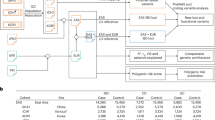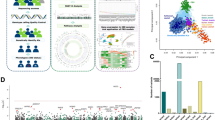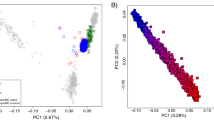Abstract
Ulcerative colitis and Crohn's disease are the two main forms of inflammatory bowel disease (IBD). Here we report the first trans-ancestry association study of IBD, with genome-wide or Immunochip genotype data from an extended cohort of 86,640 European individuals and Immunochip data from 9,846 individuals of East Asian, Indian or Iranian descent. We implicate 38 loci in IBD risk for the first time. For the majority of the IBD risk loci, the direction and magnitude of effect are consistent in European and non-European cohorts. Nevertheless, we observe genetic heterogeneity between divergent populations at several established risk loci driven by differences in allele frequency (NOD2) or effect size (TNFSF15 and ATG16L1) or a combination of these factors (IL23R and IRGM). Our results provide biological insights into the pathogenesis of IBD and demonstrate the usefulness of trans-ancestry association studies for mapping loci associated with complex diseases and understanding genetic architecture across diverse populations.
This is a preview of subscription content, access via your institution
Access options
Subscribe to this journal
Receive 12 print issues and online access
We are sorry, but there is no personal subscription option available for your country.
Buy this article
- Purchase on SpringerLink
- Instant access to full article PDF
Prices may be subject to local taxes which are calculated during checkout


Similar content being viewed by others
References
Molodecky, N.A. et al. Increasing incidence and prevalence of the inflammatory bowel diseases with time, based on systematic review. Gastroenterology 142, 46–54 (2012).
Ng, S.C. et al. Incidence and phenotype of inflammatory bowel disease based on results from the Asia-Pacific Crohn's and Colitis Epidemiology Study. Gastroenterology 145, 158–165 (2013).
Asano, K. et al. A genome-wide association study identifies three new susceptibility loci for ulcerative colitis in the Japanese population. Nat. Genet. 41, 1325–1329 (2009).
Yang, S.K. et al. Genome-wide association study of Crohn's disease in Koreans revealed three new susceptibility loci and common attributes of genetic susceptibility across ethnic populations. Gut 63, 80–87 (2014).
Juyal, G. et al. Genome-wide association scan in north Indians reveals three novel HLA-independent risk loci for ulcerative colitis. Gut 64, 571–579 (2015).
Jostins, L. et al. Host-microbe interactions have shaped the genetic architecture of inflammatory bowel disease. Nature 491, 119–124 (2012).
Mahajan, A. et al. Genome-wide trans-ancestry meta-analysis provides insight into the genetic architecture of type 2 diabetes susceptibility. Nat. Genet. 46, 234–244 (2014).
Okada, Y. et al. Genetics of rheumatoid arthritis contributes to biology and drug discovery. Nature 506, 376–381 (2014).
Pirinen, M., Donnelly, P. & Spencer, C. Efficient computation with a linear mixed model on large-scale data sets with applications to genetic studies. Ann. Appl. Stat. 7, 369–390 (2013).
Morris, A.P. Transethnic meta-analysis of genomewide association studies. Genet. Epidemiol. 35, 809–822 (2011).
Yamazaki, K. et al. A genome-wide association study identifies 2 susceptibility loci for Crohn's disease in a Japanese population. Gastroenterology 144, 781–788 (2013).
Okada, Y. et al. HLA-Cw*1202–B*5201–DRB1*1502 haplotype increases risk for ulcerative colitis but reduces risk for Crohn's disease. Gastroenterology 141, 864–871 (2011).
Juyal, G. et al. An investigation of genome-wide studies reported susceptibility loci for ulcerative colitis shows limited replication in north Indians. PLoS ONE 6, e16565 (2011).
Westra, H.J. et al. Systematic identification of trans eQTLs as putative drivers of known disease associations. Nat. Genet. 45, 1238–1243 (2013).
Rioux, J.D. et al. Genome-wide association study identifies new susceptibility loci for Crohn disease and implicates autophagy in disease pathogenesis. Nat. Genet. 39, 596–604 (2007).
Beigel, F. et al. Oncostatin M mediates STAT3-dependent intestinal epithelial restitution via increased cell proliferation, decreased apoptosis and upregulation of SERPIN family members. PLoS ONE 9, e93498 (2014).
Dastani, Z. et al. Novel loci for adiponectin levels and their influence on type 2 diabetes and metabolic traits: a multi-ethnic meta-analysis of 45,891 individuals. PLoS Genet. 8, e1002607 (2012).
Teslovich, T.M. et al. Biological, clinical and population relevance of 95 loci for blood lipids. Nature 466, 707–713 (2010).
Lee, S.H. et al. Estimation of pleiotropy between complex diseases using single-nucleotide polymorphism–derived genomic relationships and restricted maximum likelihood. Bioinformatics 28, 2540–2542 (2012).
Dickson, S.P., Wang, K., Krantz, I., Hakonarson, H. & Goldstein, D.B. Rare variants create synthetic genome-wide associations. PLoS Biol. 8, e1000294 (2010).
Anderson, C.A., Soranzo, N., Zeggini, E. & Barrett, J.C. Synthetic associations are unlikely to account for many common disease genome-wide association signals. PLoS Biol. 9, e1000580 (2011).
Wray, N.R., Purcell, S.M. & Visscher, P.M. Synthetic associations created by rare variants do not explain most GWAS results. PLoS Biol. 9, e1000579 (2011).
Beaudoin, M. et al. Deep resequencing of GWAS loci identifies rare variants in CARD9, IL23R and RNF186 that are associated with ulcerative colitis. PLoS Genet. 9, e1003723 (2013).
Rivas, M.A. et al. Deep resequencing of GWAS loci identifies independent rare variants associated with inflammatory bowel disease. Nat. Genet. 43, 1066–1073 (2011).
Kalinski, P. Regulation of immune responses by prostaglandin E2 . J. Immunol. 188, 21–28 (2012).
Bonifaz, L. et al. Efficient _targeting of protein antigen to the dendritic cell receptor DEC-205 in the steady state leads to antigen presentation on major histocompatibility complex class I products and peripheral CD8+ T cell tolerance. J. Exp. Med. 196, 1627–1638 (2002).
Fukaya, T. et al. Conditional ablation of CD205+ conventional dendritic cells impacts the regulation of T-cell immunity and homeostasis in vivo. Proc. Natl. Acad. Sci. USA 109, 11288–11293 (2012).
Izadpanah, A., Dwinell, M.B., Eckmann, L., Varki, N.M. & Kagnoff, M.F. Regulated MIP-3α/CCL20 production by human intestinal epithelium: mechanism for modulating mucosal immunity. Am. J. Physiol. Gastrointest. Liver Physiol. 280, G710–G719 (2001).
Kaser, A. et al. Increased expression of CCL20 in human inflammatory bowel disease. J. Clin. Immunol. 24, 74–85 (2004).
Varona, R., Cadenas, V., Flores, J., Martínez, A.C. & Márquez, G. CCR6 has a non-redundant role in the development of inflammatory bowel disease. Eur. J. Immunol. 33, 2937–2946 (2003).
Miyake, T. et al. IκBζ is essential for natural killer cell activation in response to IL-12 and IL-18. Proc. Natl. Acad. Sci. USA 107, 17680–17685 (2010).
Hildebrand, D.G. et al. IκBζ is a transcriptional key regulator of CCL2/MCP-1. J. Immunol. 190, 4812–4820 (2013).
Okamoto, K. et al. IκBζ regulates TH17 development by cooperating with ROR nuclear receptors. Nature 464, 1381–1385 (2010).
Duarte, J.H., Di Meglio, P., Hirota, K., Ahlfors, H. & Stockinger, B. Differential influences of the aryl hydrocarbon receptor on Th17 mediated responses in vitro and in vivo. PLoS ONE 8, e79819 (2013).
Li, Y. et al. Exogenous stimuli maintain intraepithelial lymphocytes via aryl hydrocarbon receptor activation. Cell 147, 629–640 (2011).
Serfling, E. et al. NFATc1/αA: the other face of NFAT factors in lymphocytes. Cell Commun. Signal. 10, 16 (2012).
Delaneau, O., Marchini, J. & Zagury, J.F. A linear complexity phasing method for thousands of genomes. Nat. Methods 9, 179–181 (2012).
Howie, B., Marchini, J. & Stephens, M. Genotype imputation with thousands of genomes. G3 1, 457–470 (2011).
Freedman, M.L. et al. Assessing the impact of population stratification on genetic association studies. Nat. Genet. 36, 388–393 (2004).
Shah, T.S. et al. OptiCall: a robust genotype-calling algorithm for rare, low-frequency and common variants. Bioinformatics 28, 1598–1603 (2012).
Purcell, S. et al. PLINK: a tool set for whole-genome association and population-based linkage analyses. Am. J. Hum. Genet. 81, 559–575 (2007).
Price, A.L. et al. Principal components analysis corrects for stratification in genome-wide association studies. Nat. Genet. 38, 904–909 (2006).
Higgins, J.P. & Thompson, S.P. Quantifying heterogeneity in a meta-analysis. Stat. Med. 21, 1539–1558 (2002).
Higgins, J.P. et al. Measuring inconsistency in meta-analyses. Br. Med. J. 327, 557–560 (2003).
Purcell, S., Cherny, S.S. & Sham, P.C. Genetic Power Calculator: design of linkage and association genetic mapping studies of complex traits. Bioinformatics 19, 149–150 (2003).
So, H.C., Gui, A.H., Cherny, S.S. & Sham, P.C. Evaluating the heritability explained by known susceptibility variants: a survey of ten complex diseases. Genet. Epidemiol. 35, 310–317 (2011).
Morris, J.A., Randall, J.C., Maller, J.B. & Barrett, J.C. Evoker: a visualization tool for genotype intensity data. Bioinformatics 26, 1786–1787 (2010).
Dastani, Z. et al. Novel loci for adiponectin levels and their influence on type 2 diabetes and metabolic traits: a multi-ethnic meta-analysis of 45,891 individuals. PLoS Genet. 8, e1002607 (2012).
Schramm, K. et al. Mapping the genetic architecture of gene regulation in whole blood. PLoS ONE 9, e93844 (2014).
Fehrmann, R.S. et al. Trans-eQTLs reveal that independent genetic variants associated with a complex phenotype converge on intermediate genes, with a major role for the HLA. PLoS Genet. 7, e1002197 (2011).
Raychaudhuri, S. et al. Identifying relationships among genomic disease regions: predicting genes at pathogenic SNP associations and rare deletions. PLoS Genet. 5, e1000534 (2009).
Rossin, E.J. et al. Proteins encoded in genomic regions associated with immune-mediated disease physically interact and suggest underlying biology. PLoS Genet. 7, e1001273 (2011).
ENCODE Project Consortium. A user's guide to the encyclopedia of DNA elements (ENCODE). PLoS Biol. 9, e1001046 (2011).
Cockerham, C.C. & Weir, B.S. Covariances of relatives stemming from a population undergoing mixed self and random mating. Biometrics 40, 157–164 (1984).
Acknowledgements
R.K.W. is supported by a VIDI grant (016.136.308) from the Netherlands Organization for Scientific Research (NWO) and the Broad Medical Research Program of the Broad Foundation (IBD-0318). L.F. is supported by the Netherlands Organization for Scientific Research (NWO), through NWO VENI grant 916.10.135 and NWO VIDI grant 917.14.374. The research leading to these results has received funding from the European Community's Health Seventh Framework Programme (FP7/2007–2013) under grant agreement 259867. T.B.K. is supported by Centre of Excellence grant BT/01/COE/07/UDSC/2008 from the Department of Biotechnology of the government of India (New Delhi, India). The collection of Iranian samples has been supported by the Tehran University of Medical Sciences, Iran. UK case collections were supported by the National Association for Colitis and Crohn's Disease, the Wellcome Trust, the Medical Research Council UK and the Peninsular College of Medicine and Dentistry, Exeter. We also acknowledge National Institute for Health Research (NIHR) Biomedical Research Centre awards to Guy's and St Thomas' NHS Trust/King's College London and to Addenbrooke's Hospital/University of Cambridge School of Clinical Medicine. A.P.M. is supported by the Wellcome Trust under award WT098017. J.Z.L., T.S., J.C.B. and C.A.A. are supported by the Wellcome Trust (098051).
Author information
Authors and Affiliations
Consortia
Contributions
Study design: J.Z.L., S.v.S., H.H., A.P.M., J.C.B., B.Z.A., M.P., T.B.K., M.J.D., A.F., C.A.A. and R.K.W. Collection of samples and clinical information: S.C.N., J.C.L., S.A., J.H.C., N.E.D., Y.F., A.H., R.C.J., G.J., W.H.K., H.P., W.G.N., V.M., T.R.O., H.V., A.S., J.J.Y.S., R.M., K.Y., S.-K.Y., M.K., T.B.K., A.F. and R.K.W. Quality control and genotype calling: J.Z.L., S.v.S., B.Z.A., H.H., L.J., T.S. and C.A.A. Statistical analyses: J.Z.L., S.v.S., H.H., A.T., L.J., R.A., S.R., H.-J.W., L.F., C.A.A. and R.K.W. Writing of the manuscript: J.Z.L., S.v.S., H.H., J.C.L., J.C., B.Z.A., M.P., C.A.A. and R.K.W.
Corresponding authors
Ethics declarations
Competing interests
The authors declare no competing financial interests.
Additional information
A full list of members and affiliations appears in the Supplementary Note.
A full list of members and affiliations appears in the Supplementary Note.
Supplementary information
Supplementary Text and Figures
Supplementary Figures 1–6 and 8–11, Supplementary Tables 4, 8, 10, 11 and 12, and Supplementary Note (PDF 2591 kb)
Supplementary Table 1
Association statistics from the trans-ancestry meta-analysis for all previously identified and novel loci. (XLSX 312 kb)
Supplementary Table 2
Minimal P values for association within each of the 231 IBD loci for each separate ancestral cohort. (XLSX 90 kb)
Supplementary Table 3
Heterogeneity of effect of associations among the four ancestry cohorts. (XLSX 117 kb)
Supplementary Table 5
Association results for the current analysis for all previously reported variants associated with non-European IBD. (XLSX 17 kb)
Supplementary Table 6
Functional Annotation 38 Novel SNPs - Expression Quantitative Trait Loci (eQTL) for the 38 novel IBD risk loci. (XLSX 60 kb)
Supplementary Table 7
ENCODE annotation of the 38 novel IBD risk SNPs. (XLSX 45 kb)
Supplementary Table 9
Functional annotation - GRAIL and DAPPLE results. (XLSX 68 kb)
Supplementary Figure 7
Regional plots for the 38 novel IBD loci. (PDF 7676 kb)
Rights and permissions
About this article
Cite this article
Liu, J., van Sommeren, S., Huang, H. et al. Association analyses identify 38 susceptibility loci for inflammatory bowel disease and highlight shared genetic risk across populations. Nat Genet 47, 979–986 (2015). https://doi.org/10.1038/ng.3359
Received:
Accepted:
Published:
Issue Date:
DOI: https://doi.org/10.1038/ng.3359



